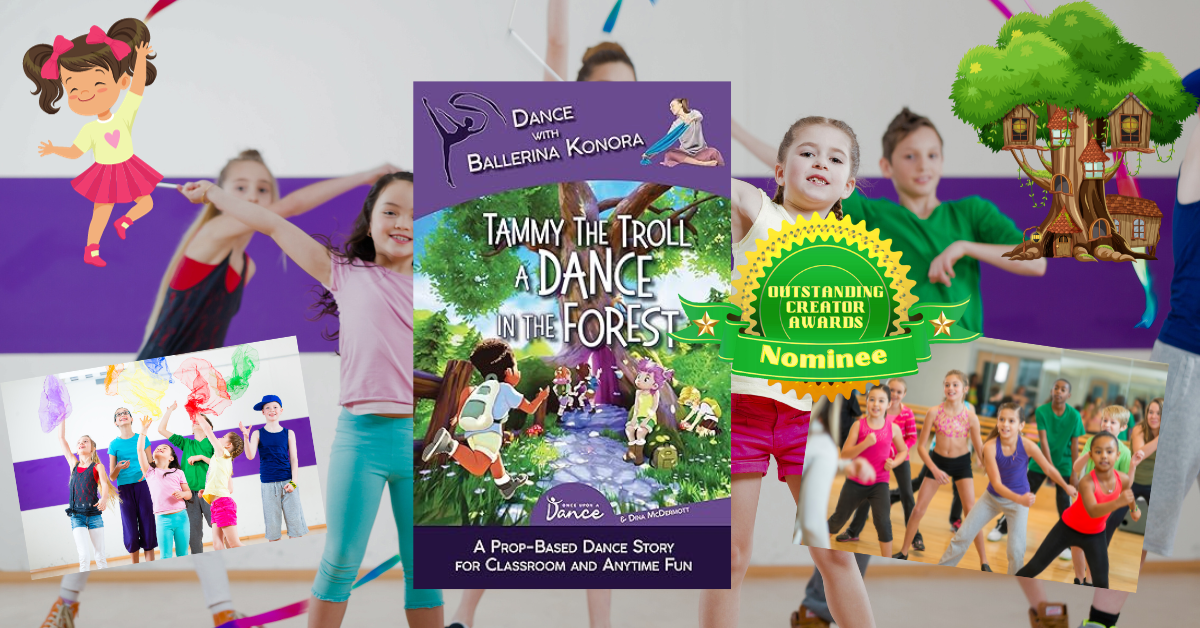|
Score: 92+/100 (9.2+ out of 10)
Tammy the Troll is another fun, exciting children's dance book by Once Upon a Dance. This particular book is an ambitious collaboration with author Dina McDermott. According to McDermott, Tammy the Troll is a story that she's developed and shared with dance students for thirty years! It is brought to life via the bright, colorful illustrations of Cristian Gheorghita, whose incredible art-style we recognized from Eka & the Elphants, arguably our favorite Once Upon a Dance book. It is also brought to life via the dance demonstrations of the beautiful, gorgeous, cute, skilled, and very talented Ballerina Konora, the mascot and icon of Once Upon a Dance. As in other books in the series, Konora appears throughout the book, demonstrating the dance moves or actions that correspond to that particular section. Konora is almost always one of our favorite parts of every Once Upon a Dance book, along with the cute animals. She has a charisma that's only matched by the likes of Mr. Rogers, Loonette from Big Comfy Couch, or Steve from Blues Clues. Konora is the perfect person to put in that role. We could actually imagine her having her own children's TV show alongside her mom and some puppets portraying the characters/animals. It would be a hit! Well, in this book, we don't quite have an animal character, we have a mystical creature: a troll! For anyone who grew up in the 80s to mid-90s, troll dolls were likely a familiar and welcomed sight (alongside Beanie Babies). Well, Tammy, the titular troll of the book, definitely takes inspiration from these dolls with her tall, wild, bright-purple hair, a diamond on her belly, and a contagious smile. In this interactive story, a group of children go out to meet Tammy at her tree home in the woods. It is implied, though not stated, that this is a special occasion for Tammy, perhaps her birthday (as the children bring a present with them). It is also possible that the children are just nice friends who want to give her a gift. The children go through many obstacles to reach Tammy, then to return home with her. They climb through trees, climb up mountains, roll down hills, and go over the river in a row boat. All the while, Ballerina Konora provides the audience with dance moves to accompany each part of this grand adventure. Also new to this book are some of the direct instructions for teachers and dance instructors to use, indicated by hand symbol. The little adventure that the children go on is quite engaging, especially with the dance moves. This book reminded us a lot of Going on a Bear Hunt, a popular children's book/song that was in circulation in preschools in the 2010s. Like this story, it involved children going on an adventure through the woods, over mountains, and across rivers to find someone (Tammy the troll or the Big Scary Bear). This is, undoubtedly, a lot less scary and dark than that story was. However, one thing that this book could've benefited in borrowing from Going on a Bear Hunt is repetition. In Tammy the Troll, it always seems like the story and characters are running away and ahead of you instead of running with you. The flow of the story goes from one thing to the next, and it can be a bit overwhelming .Movements and situations change after every page or every other page, so there are times when you may find yourself lost or falling behind. Every dance routine should have repetition—certain motions that are repeated almost like a bridge or a chorus to the rest of the song/routine. This book may have benefited by having some movements that were repeated to add continuity and familiarity to it. It's the “aha” moment that every dancer looks for—the sequence of motions that they can immediately fall back on when they get lost. Another thing we noticed is that this book missed out in giving the human characters a bit more character. For example, in Eka and the Elephants, Eka was a distinct person and character. The same was true for Andi in Andi's Valentine Tree and Sora in Sora Searches for a Song. In this book, all the human characters seem to blend and blur together. This is a little unfortunate because this series of books has become known for its deep, emotionally-complex characters. However, this all might have something to do with the fact that this book is a lot less wordy, and so includes a lot less exposition and character development than other books. That leads us to our next key point. This book does shows massive improvement in one key area: being more concise. We have noticed that a lot of Once Upon a Dance book tended to be on the wordy side (in terms of children's books). This book was a lot more concise and brief in its presentation of information. Instead of being presented with huge blocks of texts to accompany the dance routines and story, we are simply supplied with maybe 8-12 words at a time. If Once Upon a Time could find a balance between this brevity and the character depth that the wordiness in previous books allowed, we could be looking at near-perfect children's books! One last thing to note, this book probably makes the most use of apparatuses than any of the other Once Upon a Dance books. It is recommended that the readers use two scarves and a backpack to help them on their adventure. We've found that apparatuses (and instruments) can really help to make an experience like this more engaging and fun for children. Check this out on Amazon!
0 Comments
Leave a Reply. |
Archives
July 2024
Categories |

 RSS Feed
RSS Feed